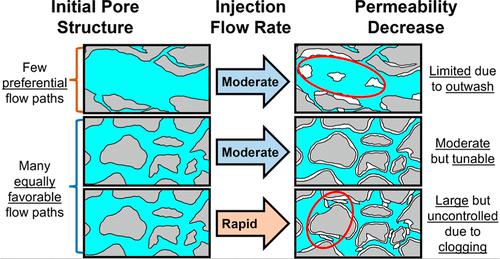当前位置:
X-MOL 学术
›
ACS Earth Space Chem.
›
论文详情
Our official English website, www.x-mol.net, welcomes your feedback! (Note: you will need to create a separate account there.)
Hydrodynamic Limitations on Biomineralization-Induced Permeability Reduction
ACS Earth and Space Chemistry ( IF 3.4 ) Pub Date : 2024-03-08 , DOI: 10.1021/acsearthspacechem.3c00337 Eva M. Albalghiti 1 , Brian R. Ellis 1
ACS Earth and Space Chemistry ( IF 3.4 ) Pub Date : 2024-03-08 , DOI: 10.1021/acsearthspacechem.3c00337 Eva M. Albalghiti 1 , Brian R. Ellis 1
Affiliation

|
While the subsurface applications of microbially induced carbonate precipitation (MICP) have so far emphasized near-wellbore permeability reduction, MICP technology may eventually be expanded to support needs as diverse as thief zone remediation in geothermal reservoirs or caprock sealing in CO2 sequestration sites. For these applications to be realized, however, there is a need to understand whether permeability reduction can be achieved under the high flow velocities that may occur, for example, in zones of locally high permeability or along preferential flow paths. In this study, bioaugmented MICP is applied to three natural limestone cores of similar porosity but differing pore size distribution. The injection strategy includes biomass attachment and growth phases before mineralization, with the goal of separating the effects of each phase on permeability. In order to test the resilience of biomass and precipitate accumulation against flow-induced shear stress, saline solution is injected intermittently at a faster flow rate. Real-time permeability estimates show that biomass accumulation reduces permeability even without mineralization, although biomass accumulation may ultimately be shear-limited. Calcium mass balances suggest that sloughing of precipitates is also possible, though its effect on permeability depends on whether mobilized precipitates induce clogging or are transported out of the core. X-ray computed microtomography imaging of the cores suggests that when flow rates are moderate and preferential flow paths do not dominate flow, precipitates tend to accumulate preferentially in larger pores, yielding controlled, incremental permeability reduction. These findings lay essential groundwork toward refining MICP models to account for spatial heterogeneities in the subsurface.
中文翻译:

生物矿化引起的渗透率降低的流体动力学限制
虽然微生物诱导碳酸盐沉淀 (MICP) 的地下应用迄今为止强调近井筒渗透率降低,但 MICP 技术最终可能会扩展到支持多种需求,例如地热储层的窃贼区修复或 CO 2 封存地点的盖层密封。然而,为了实现这些应用,需要了解是否可以在可能发生的高流速下实现渗透率降低,例如在局部高渗透率区域或沿优先流动路径。在这项研究中,生物增强 MICP 应用于孔隙率相似但孔径分布不同的三个天然石灰岩岩心。注入策略包括矿化前的生物质附着和生长阶段,目的是分离每个阶段对渗透性的影响。为了测试生物质和沉淀物积累对流动引起的剪切应力的恢复能力,以更快的流速间歇地注入盐水溶液。实时渗透率估计表明,即使没有矿化,生物量积累也会降低渗透性,尽管生物量积累最终可能受到剪切限制。钙质量平衡表明沉淀物脱落也是可能的,尽管它对渗透性的影响取决于移动的沉淀物是否引起堵塞或被输送出岩心。岩心的 X 射线计算机显微断层扫描成像表明,当流速适中且优先流动路径不占主导地位时,沉淀物倾向于优先积聚在较大的孔隙中,从而产生受控的增量渗透率降低。这些发现为完善 MICP 模型以解释地下空间异质性奠定了重要基础。
更新日期:2024-03-08
中文翻译:

生物矿化引起的渗透率降低的流体动力学限制
虽然微生物诱导碳酸盐沉淀 (MICP) 的地下应用迄今为止强调近井筒渗透率降低,但 MICP 技术最终可能会扩展到支持多种需求,例如地热储层的窃贼区修复或 CO 2 封存地点的盖层密封。然而,为了实现这些应用,需要了解是否可以在可能发生的高流速下实现渗透率降低,例如在局部高渗透率区域或沿优先流动路径。在这项研究中,生物增强 MICP 应用于孔隙率相似但孔径分布不同的三个天然石灰岩岩心。注入策略包括矿化前的生物质附着和生长阶段,目的是分离每个阶段对渗透性的影响。为了测试生物质和沉淀物积累对流动引起的剪切应力的恢复能力,以更快的流速间歇地注入盐水溶液。实时渗透率估计表明,即使没有矿化,生物量积累也会降低渗透性,尽管生物量积累最终可能受到剪切限制。钙质量平衡表明沉淀物脱落也是可能的,尽管它对渗透性的影响取决于移动的沉淀物是否引起堵塞或被输送出岩心。岩心的 X 射线计算机显微断层扫描成像表明,当流速适中且优先流动路径不占主导地位时,沉淀物倾向于优先积聚在较大的孔隙中,从而产生受控的增量渗透率降低。这些发现为完善 MICP 模型以解释地下空间异质性奠定了重要基础。



























 京公网安备 11010802027423号
京公网安备 11010802027423号